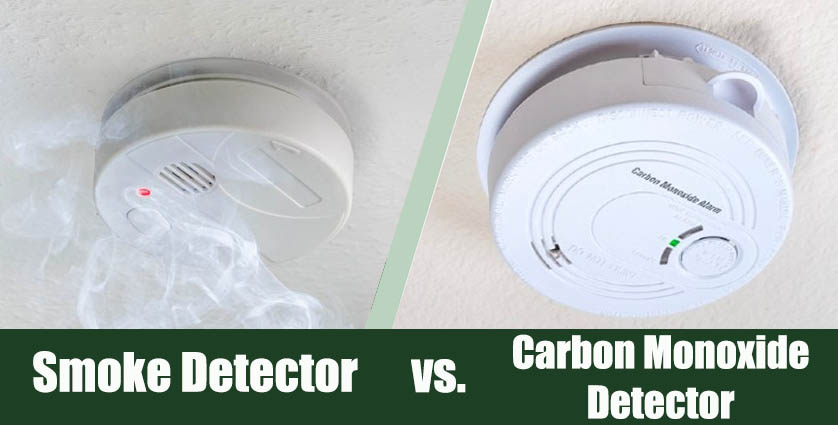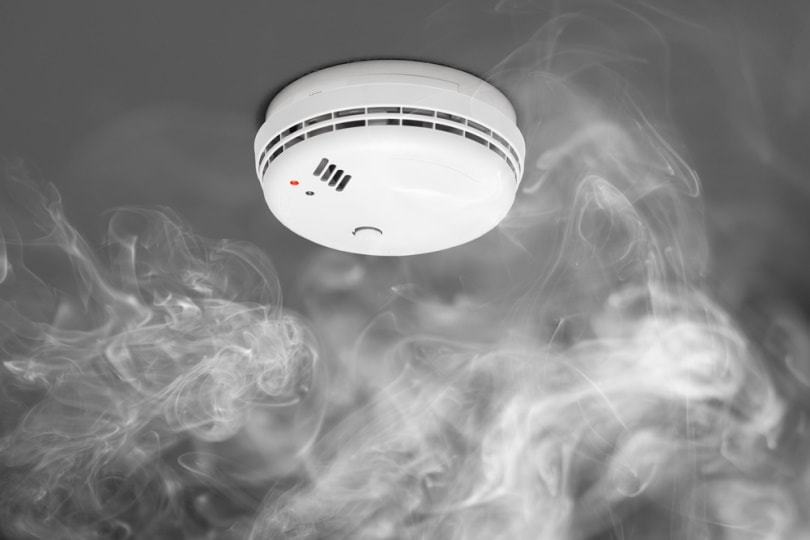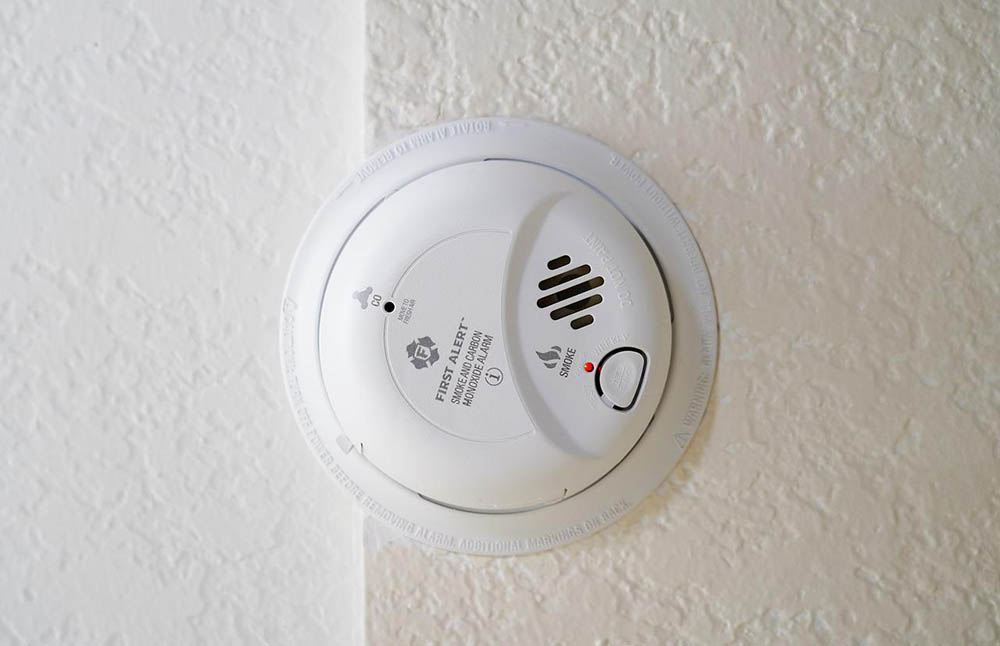Smoke Detector vs Carbon Monoxide Detector: Types, Differences, & FAQ
-
Pete Ortiz
- Last updated:

Making your home safer doesn’t start with expensive security systems. While many people focus on smart locks, alarms, and cameras, it’s easy to forget that we live every day with potential hazards inside our homes.
According to the NFPA, nearly 350,000 residential fires result in 2,620 deaths and over $7.3 billion in damage annually. Meanwhile, carbon monoxide poisoning kills at least 430 Americans each year and injures roughly 50,000 more.
Smoke and carbon monoxide detectors provide daily peace of mind that your family is safe from some of life’s most severe threats. Although they look similar, these appliances serve particular purposes. Using one in place of the other isn’t only redundant but dangerous. To help you ensure your home and family are safe, we’ll break down the differences between smoke detectors and carbon monoxide detectors.
 Smoke Detectors
Smoke Detectors
Smoke detectors are small devices that detect smoke, excessive heat, or fire. When they sense a threat, they signal an alarm system to go off, which includes a loud noise and flashing lights. Units mount to walls or ceilings throughout the home.

Types of Smoke Detectors
Battery-powered and hardwired smoke detectors are available. Hardwired smoke detectors include battery backups in case the power goes out.
Many battery units use replaceable 9V, AAA, or AA batteries and will alert you when the batteries are low. Other smoke detectors run off of 10-year sealed batteries that won’t need any replacement for the entire 10-year life of the unit. Though you usually won’t need to do any maintenance on these devices, you must still test them monthly.
Newly constructed homes need hardwired smoke detectors to abide by most building codes. Older houses built in the late ’90s or earlier stay up to code with battery-powered units. Some local laws require upgrades to hardwired units during renovations.
Along with the power source, smoke detectors can differ in how they sense smoke. There are two basic types of smoke detectors: photoelectric and ionization.
- Photoelectric: An alarm signals when smoke inside the unit diffuses light from a beam to a sensitive photoelectric cell
- Ionization: An alarm goes off when smoke disrupts a signal between two diodes exchanging an electrical current
Photoelectric detectors are generally the most dependable and least susceptible to false alarms. They respond much faster in the early stages of a fire as it smolders, often activating in about 30 minutes. By contrast, ionization detectors react quicker to fast-flaming fires. They can send out alerts 30–90 seconds sooner than photoelectric units.
Dual-sensor smoke detectors combine photoelectric and ionization detection mechanisms. Modern combos include smoke and heat detection capabilities for more comprehensive protection. Some of the most advanced rapid-response systems include aspirating mechanisms. An aspirating smoke detector draws in and analyzes air for smoke, supplying even faster response times.
Importance of Smoke Detectors
Several safety devices beyond smoke detectors can alert people to a fire threat. For instance, flame detectors use UV or infrared systems to detect flames without needing the presence of smoke. A heat detector works similarly, checking for high-temperature spikes typical of a fire.
Flame and heat detectors are more practical than smoke detectors in situations where they would constantly go off. Smokey spaces or dusty areas can easily set off detectors, so an alternative sensor can sometimes be more practical. These devices can be crucial in preventing property damage. But for protecting your family, there is no replacement for a quality smoke detector.
Most people killed in house fires do not die from burn injuries but instead succumb to smoke inhalation. Smoke reaches and overcomes victims much faster than the fire, incapacitating them and putting them in danger.
Smoke detectors will alert you to a fire threat faster than flame and heat detectors. If you’re in bed on the top floor and a fire breaks out in the basement, the rising smoke will reach you quicker than the flame. The heat detector waits for the fire to spread throughout the house before activating, which could be too late. A smoke detector will go off before the smoke can overtake the space.
Carbon Monoxide Detectors
Carbon monoxide detectors look like smoke detectors and sound alarms in the same way. They warn you when carbon monoxide levels maintain a particular ppm for a specified time. They are crucial in homes with gas fixtures such as ovens, furnaces, and water heaters. These appliances may emit hazardous carbon monoxide when they fail to burn their fuel completely.

Types of Carbon Monoxide Detectors
Because carbon monoxide is odorless and invisible, CO detectors need different sensors than those in smoke detecting units. There are three types of carbon monoxide sensors:
- Biomimetic: A gel-coated disc absorbs CO and changes color, which signals the alarm
- Metal Oxide Semiconductor: A silica chip on an electronic board senses CO and reduces its electrical resistance to set off the alarm
- Electrochemical: Electrodes sit in a chemical bath and send a signal when CO disrupts the current
Electrochemical is the most reliable and responsive type of carbon monoxide detector.
Carbon monoxide detectors are available in hardwired, battery-operated, or plug-in styles. Metal oxide semiconductors draw a significant amount of power and therefore need to plug into an outlet.
Most carbon monoxide detectors last for roughly 7 years. Once they reach end-of-life mode, dying units emit a recurring beep and flashing light to signal they need a replacement.
Importance of Carbon Monoxide Detectors
Fuel-burning appliances create carbon monoxide whenever they’re in use, so there are several ways that CO can find its way into the home. A blocked chimney, an overworked oven, or a cracked heat exchanger in the furnace are only a few of the many potential carbon monoxide sources.
Unlike smoke, carbon monoxide is difficult to detect even as it’s all around you, making it particularly hazardous. It has no color, odor, or taste. Prolonged exposure eventually causes flu-like symptoms such as headaches, upset stomach, fatigue, and dizziness.
Given enough time to replace the oxygen in your blood, carbon monoxide will cause you to become disoriented and pass out. When concentrations reach 150–200 ppm, you can develop symptoms within a couple of hours and potentially die.
How Much Do Smoke and Carbon Monoxide Detectors Cost?
Smoke detectors can cost under $10 a piece, but quality photoelectric models start around $20–$30. High-end units can run over $65. Carbon monoxide detectors cost roughly the same price as smoke detectors.
You can also buy all-in-one smoke and carbon monoxide detectors. These cost around the same price as separate units. Multi-packs are another popular option, supplying you with an entire house’s worth of devices at a discounted price per unit.

Where Should I Place Carbon Monoxide Detectors?
Carbon monoxide is slightly lighter than air, so you should place CO detectors at least 5 feet up a wall or on the ceiling 6 inches from the wall. Each floor should have at least one carbon monoxide detector. The Consumer Product Safety Commission recommends putting one outside each sleeping area. Check your local safety codes for specific requirements.
Attics and basements do not typically need detectors unless they include sleeping spaces. Some authorities recommend using them in these areas if they contain fuel-burning appliances. It’s critical to avoid placing detectors directly above or next to appliances that may emit carbon monoxide, as doing so can result in frequent false alarms.
Where Should I Place Smoke Detectors?
Safety requirements vary between municipalities. You must always check your local codes for directions on where to place smoke detectors. Most local laws require one smoke detector inside each bedroom. There should also be one in the hall directly outside each sleeping area. Multiple wings on a floor will require multiple detectors. There should be a smoke detector on each floor, including the basement and attic, preferably near stairwells.
Since smoke rises, detectors should sit on the ceiling or high on the wall within 12 inches from the top. Pitched ceilings should have detectors within 36 inches of the apex but not directly on it. If your home is new, you must install hardwired smoke detectors.
What Are Interconnected Smoke Alarms?
Interconnected smoke detectors function together to go off at one time. If a smoke detector goes off in the basement, every other alarm in the house will sound, and you’ll be able to respond much quicker to the threat.
Many hardwired smoke and carbon monoxide detector systems are interconnected. Most building and safety codes require them in new constructions. You can also buy battery-powered detectors that can interconnect with like-branded units. When activated, these models send out a wireless signal to the other alarms telling them to turn on.

Do You Need Carbon Monoxide Detectors If You Don’t Use Gas?
You should install carbon monoxide detectors in your home whether or not you have gas appliances. Dangerous carbon monoxide doses can seep in from several places, such as
- Attached garages with a running vehicle
- Portable gas grills and appliances
- Gas generators running close to the home
Setting up carbon monoxide detectors will protect you from any possible threat. Plus, it will prepare your home if you want to install a gas appliance in the future.
Will a Carbon Monoxide Detector Detect a Fire?
Carbon monoxide is present while a fuel burns, so it makes sense that CO detectors could signal an uncontrolled fire. One study showed they could even sense early-stage smoldering fires faster than photoelectric units. While the findings point to the utility of CO detectors, they don’t diminish the effectiveness of smoke detectors.
CO detectors are invaluable when carbon monoxide buildup outpaces the smoke. In these situations, you and your family could be at risk before the smoke alarm sounds. But smoke detectors may sound much earlier in fast-flaming fires. Using both types throughout the home will give you a complete response system for any fire or carbon monoxide threat.
Conclusion
With greater use, smoke and carbon monoxide detectors could prevent billions of dollars in damage and thousands of deaths every year. It takes little effort and only a few dollars to upgrade the security around your home. Test your system, change batteries, and buy new detectors as needed. When it comes to protecting your family and your home, the smallest steps today could make all the difference tomorrow.
Featured Image Credit: (Left) Zerbor, Shutterstock; (Right) Leena-Robinson, Shutterstock
Contents

 Smoke Detectors
Smoke Detectors